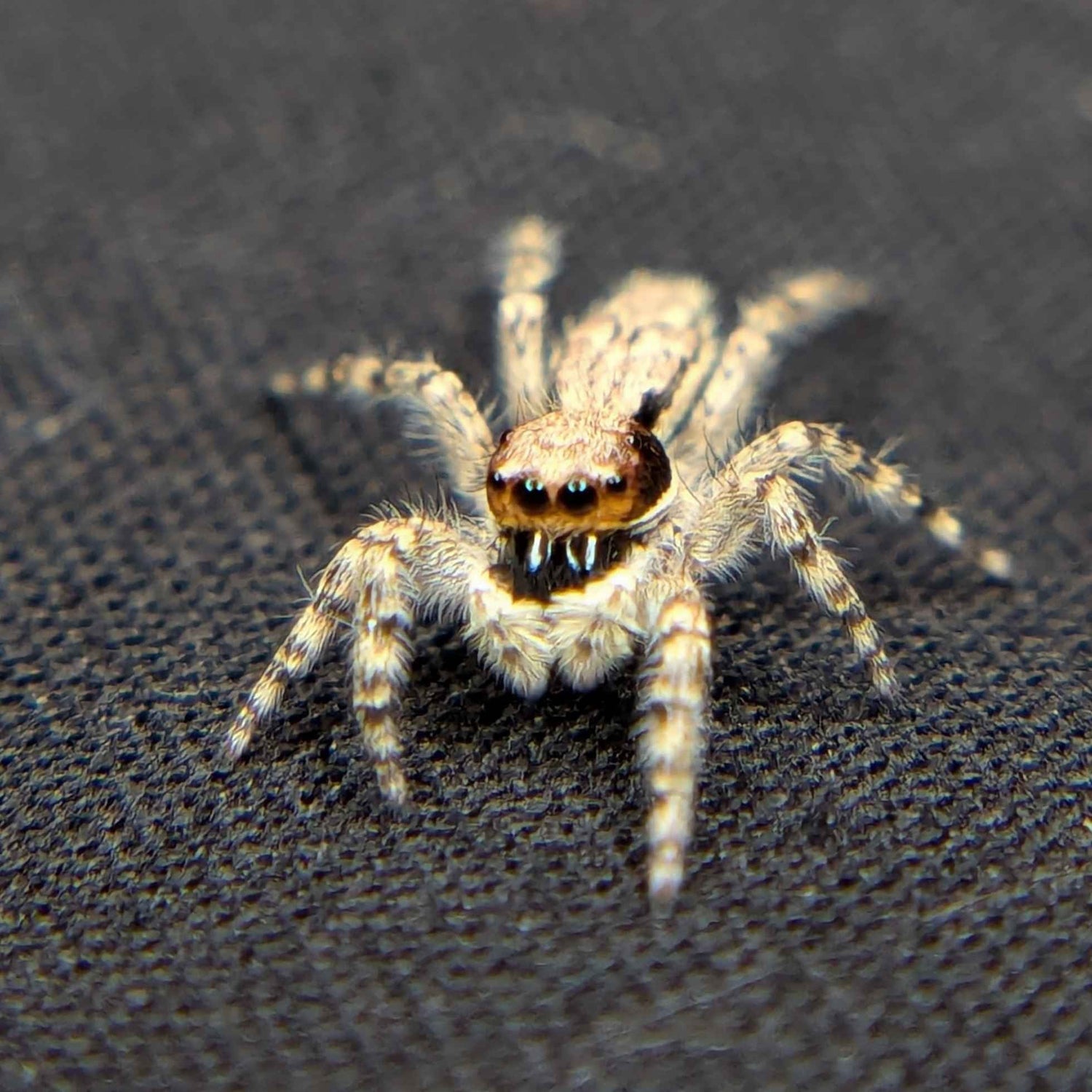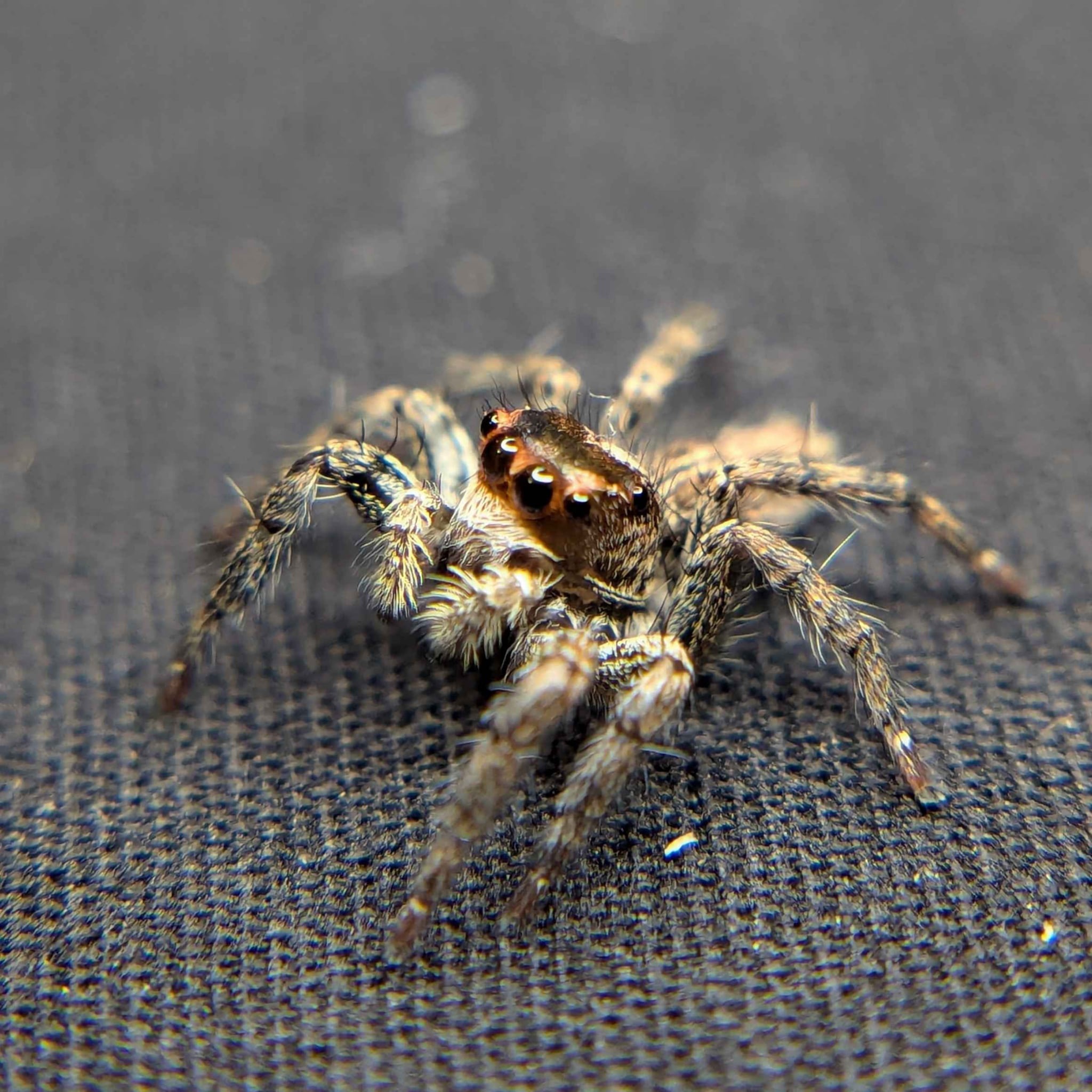Menemerus bivittatus, commonly known as the Gray Wall Jumping Spider, is an active and inquisitive species of jumping spider. This species is easily recognized by its distinctive markings, with a characteristic grayish color and a pair of dark, prominent stripes running down its back, giving it the “bivittatus” name. These spiders are native to parts of Europe, Africa, and Asia, but can also be found in other regions around the world. As a relatively small but very active spider, Menemerus bivittatus makes an excellent pet for spider enthusiasts, offering plenty of entertainment due to its hunting behavior, agility, and curious nature.
Here’s a complete care guide to help you care for your Gray Wall Jumping Spider.
Basic Information
Scientific Name: Menemerus bivittatus
Common Name: Gray Wall Jumping Spider
Family: Salticidae (Jumping Spiders)
Size: Approximately 1–1.5 cm (body length, excluding legs)
Lifespan: 1-2 years (females generally live longer than males)
Native Range: Found throughout Europe, Africa, Asia, and the Middle East, as well as introduced to other regions including North America
Enclosure Setup
Terrarium Size: A small enclosure 4x4x4inch in size is sufficient for Menemerus bivittatus.
Substrate: Although not required, jumping spiders do not burrow, so the substrate can be quite shallow. Use coconut fiber, peat moss, or paper towels for easy cleaning if you choose to go this route. Aim for a depth of up to 1 inch. Ensure the substrate stays dry to avoid mold and mite issues.
Climbing Structures: As Menemerus bivittatus is an excellent climber and jumper, it’s essential to provide plenty of vertical surfaces. Use branches, cork bark, or twigs to offer plenty of options for climbing and jumping. You can also include silk plants to provide more climbing opportunities and to mimic its natural environment.
Hide: Although this species is not highly secretive, providing a small hide is important. Use small pieces of bark or cork tubes that give the spider a place to rest, molt, or retreat to when it feels insecure.
Ventilation: Proper ventilation is crucial to avoid mold and fungal growth. Ensure the enclosure has sufficient air holes for airflow. Keep humidity levels balanced to avoid excess moisture in the tank, which could cause issues.
Temperature and Humidity
Temperature: Menemerus bivittatus thrives in moderate temperatures. The ideal temperature range is between 21–26°C (70–79°F). Room temperature is usually fine, but avoid placing the enclosure in areas where temperatures exceed 30°C (86°F), as this can stress the spider.
Humidity: This species prefers moderate humidity of around 50–60%. It’s important not to let humidity rise too much, as this can promote mold and mites. Light misting 1-2 times a week will maintain proper humidity levels. Always make sure the enclosure has good ventilation.
Diet and Feeding
Food: Menemerus bivittatus is a carnivorous and active hunter. Provide small live prey such as fruit flies, small crickets, house flies, mealworms, or tiny roaches. Prey should be no larger than about half the size of the spider, so it can easily overpower it.
Feeding Frequency: Feed adult spiders 2–3 times per week. Juvenile spiders might need more frequent feedings, such as every 1–2 days. If prey is not consumed within 24 hours, remove any uneaten food to prevent it from decomposing and attracting pests.
Water: Jumping spiders drink water droplets, so it’s a good idea to mist the enclosure lightly to provide moisture. Alternatively, place a shallow water dish in the enclosure, but be sure it is small and shallow enough that the spider cannot drown.
Behavior and Interaction
Activity: Menemerus bivittatus is an active and curious species. You’ll often find it climbing, leaping, and stalking prey. Its excellent vision allows it to observe its surroundings with precision, and it may even “look at you” if you approach the enclosure.
Interaction: These spiders are non-aggressive toward humans. They are not prone to biting, but may bite if threatened or handled roughly. Bites from Menemerus bivittatus are not harmful to humans and generally cause only mild irritation.
Solitary Nature: As with most jumping spiders, Menemerus bivittatus is solitary and should not be housed with other spiders, as they may become territorial and fight.
Molting and Growth
Like other spiders, Menemerus bivittatus will undergo ecdysis (molting) as it grows. During molting, the spider sheds its old exoskeleton and may become temporarily sluggish or inactive. It is crucial to leave the spider undisturbed during this time, as it can be vulnerable.
After molting, the spider will appear soft and might be slow-moving until its new exoskeleton hardens. Be sure to give it some time before attempting to feed it again after a molt.
Common Health Issues
Dehydration: Symptoms of dehydration in jumping spiders include lethargy, refusal to eat, and a shriveled body. Ensure the spider has access to water droplets or a shallow water dish, and maintain proper humidity levels.
Obesity: Jumping spiders can become overweight if fed too frequently or with large prey. If the spider becomes sluggish or seems uninterested in food, consider reducing the amount or frequency of feeding.
Mites: Mites can sometimes infest an enclosure if conditions are too moist or unclean. To prevent mites, maintain proper ventilation and humidity levels. Clean the enclosure regularly, and remove any uneaten food promptly.
Mold: Excessive moisture or poor ventilation can cause mold to grow inside the enclosure. To prevent mold, avoid over-wetting the substrate, and ensure proper airflow in the enclosure.
Breeding and Reproduction
Mating Behavior: Mating involves a courtship display from the male, where he may offer the female a small prey item, vibrate, or display his body in various ways to gain her attention. If she is receptive, mating will take place, but females can sometimes be aggressive.
Egg Sac and Spiderlings: After mating, the female will lay an egg sac, which she will guard. The sac typically contains several dozen eggs. After a few weeks, the spiderlings will hatch and begin to disperse.
Raising Spiderlings: If you wish to raise the spiderlings, you will need to provide them with small prey such as fruit flies or pinhead crickets. Keep them separated as they grow, as juvenile spiders may cannibalize each other if housed together.
Conclusion
Menemerus bivittatus (Gray Wall Jumping Spider) is an intriguing and manageable species of jumping spider, making it an excellent choice for pet owners who enjoy observing active and curious predators. By providing a well-ventilated enclosure with climbing structures, appropriate humidity and temperature, and a varied diet, you can create an environment where this spider will thrive.
Enjoy watching your spider leap and stalk its prey, and observe its unique behaviors that make it one of the most entertaining species in the world of arachnids.




Leave a comment
This site is protected by hCaptcha and the hCaptcha Privacy Policy and Terms of Service apply.